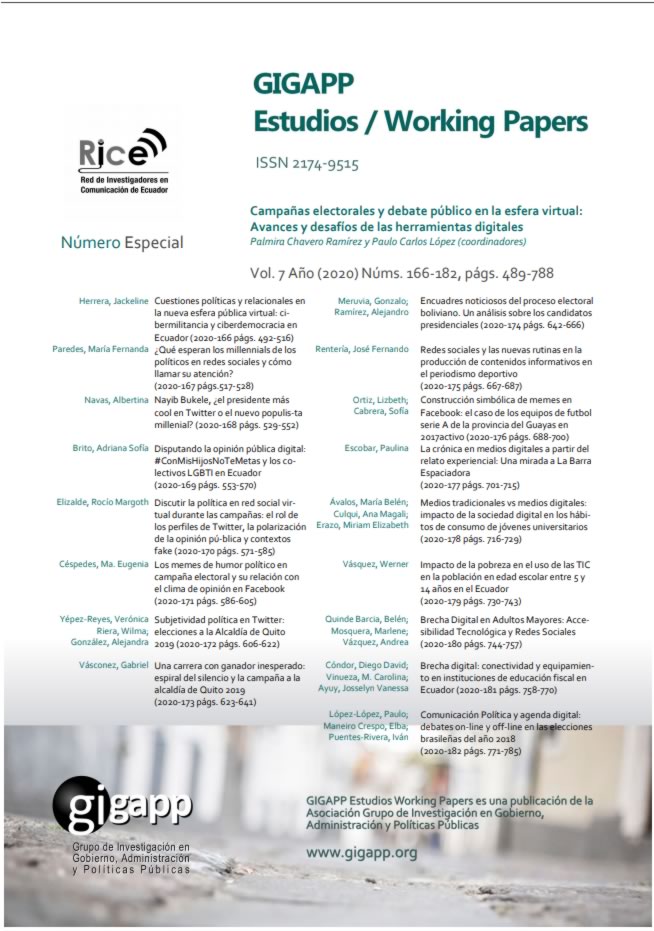Brecha Digital en Adultos Mayores: Accesibilidad Tecnológica y Redes Sociales
Resumen
Los adultos mayores conforman una parte fundamental de la sociedad, pero a medida que las tecnologías avanzan su uso se convierte en un reto y la sociedad no logra integrarlos. Este estudio tiene como objetivo realizar un análisis comparativo de las dificultades que presentan los adultos mayores en el momento de utilizar internet en dos ciudades de la provincia del Guayas, específicamente en la Asociación Hilos Plata del Cantón General Villamil Playas y la Asociación Alegría de Vivir de Guayaquil. El diseño de la investigación es cuantitativo de tipo descriptivo y transversal con una muestra de 50 adultos mayores, con un rango de edad comprendido entre los 60 a 92 años. El tipo de muestreo es no probabilístico e intencional, formado por una muestra de 50 adultos mayores y con una media de 75,6 años de edad. Se obtuvo la información a través de la encuesta Internet en Mayores (INMA) diseñada para evaluar el uso y las dificultades en el acceso y manejo de internet en personas mayores. Los resultados muestran que, incluso los adultos mayores residentes en ciudades con oportunidades de desarrollo, carecen de conocimientos sobre cómo acceder y utilizar las nuevas tecnologías. Por tanto, se evidencia la necesidad de crear oportunidades de desarrollo tecnológico dirigidos hacia el adulto mayor y, por ende, mejorar su bienestar y calidad de vida.
Descargas
Citas
Agudo, S., y Fombona, J. 2013. Impacto de las Tic en las personas mayores en Asturias: Mejora del auto-concepto y de la satisfacción, Revista electrónica de tecnología educativa, 2(44).
Aldana, G., y García, L. 2012. Las tecnologías de la información y comunicación (TIC) como alternativa para la estimulación de los procesos cognitivos en la vejez, Revista de investigación educativa, 14: 154-166.
Belando, M. 2015. Las TIC y la educación en los estudios sobre la fragilidad en personas mayores, Revista de currículum y formación de profesores, 19(3): 348-360.
Casamayou, A., y Morales, M. 2017. Personas mayores y tecnologías digitales: desafíos de un binomio, Psicología, Conocimiento y Sociedad, 7(2): 199-226.
Centro Latinoamericano y Caribeño de Demografía. 2002. Boletín Informativo: Los Adultos Mayores En América Latina y El Caribe. Chile.
Del Prete, A., Gisbert, M., y Camacho, M. 2013. Las Tic como herramienta de empoderamiento para el colectivo de mujeres mayores: El caso de la comarca del Montsia (Cataluña), Revista de Medios y Educación, 43: 37-50.
Díaz, C., y García, J. 2015 Internet en mayores, Revista de Psicología, 2(1): 35-41.
Instituto Nacional de Estadística y Censos. 2010. Tecnología de la información y comunicación. Disponible en web: http://www.ecuadorencifras.gob.ec/tecnologias-de-la-informacion-y-comunicacion-tic/ [Consultado 27-06-2018].
Instituto Nacional de Estadística y Censos. 2017. Tecnología de la información y comunicación. Recupe-rado en web: http://www.ecuadorencifras.gob.ec/tecnologias-de-la-informacion-y-comunicacion-tic/ [Consultado 28-06-2018].
Lorenzo, L. 2017. ¿De verdad los mayores en España están e-conectados?. Inguruak,63: 136 - 152.
Larsson, E., Larsson-Lund, M. & Nilsson, I. 2013. Internet Based Activities (IBAs): Seniors’ Experiences of the Conditions Required for the Performance of and the Influence of these Conditions on their Own Participation in Society, Educational Gerontology, 39(3): 155-167.
Lozada, S., y Rueda, R. 2010. Envejecimiento Cutáneo, Rev. Asoc. Colomb Dermatol, 18: 10-17.
Ministerio de inclusión Económica y social. 2013. Agenda de igualdad para Adultos mayores. Ecuador.
Ministerio de Telecomunicaciones y de la Sociedad de la Información. 2014. Libro blanco de territorio digitales en Ecuador. Disponible en web: http://www.observatoriotic.mintel.gob.ec/ [ Consultado 15- 07-2018]
Miranda, J. G. 2005. Envejecimiento Salud y dependencia, España: Universidad de la Roja, 42: 207.
Naciones Unidas. 2017. Envejecimientos. Disponible en web: https://www.un.org/es/sections/issues-depth/ageing/index.html [Consultado 26-07-2018].
Olphert, W.; Damodaran, L. 2013. Older People and Digital Disengagement: A Fourth Digital Divide, Gerontology, 59 (6): 564-70.
Organización Mundial de la Salud. 2015. Informe mundial sobre el envejecimiento y la salud. Suiza: Orga-nización Mundial de la Salud.
Paz, C., García, N., Fernández, J., y Maestre, G. 2016. El uso de las Tic en adultos mayores en Maracaibo (Venezuela), Opción, 32(12): 169-188.
Peral, B., Arenas, J., y Francisco, A. 2015. De la brecha digital a la brecha psicodigital: Mayores y redes sociales, Revista Científica de Educomunicación, 23(45): 57-64.
Pro-Ecuador. 2018. Tics. Disponible en web: https://www.proecuador.gob.ec/tics/ [ 05-08-2018].
Pino, M., Soto, J., y Rodríguez, B. 2015. Las personas mayores y las Tic: Un compromiso para reducir la brecha digital, Revista interuniversitaria, 26: 337-359.
Ramón, S., Almansa, A., y Cruz, M. 2016. Adultos y mayores frente a las TIC. La competencia mediática de los inmigrantes digitales, Revista científica de educomunicaión, 24(49): 101-109.
Silver, M. P. 2014. Socio economic status over the lifecourse and internet use in older adulthood, Ageing and Society, 34(6): 1019-1034.
Tello, E. 2008. Las tecnologías de la información y comunicaciones (TIC) y la brecha digital: su impacto en la sociedad de México. Revista de Universidad y Sociedad del conocimiento, 4(2).
Torres, I., y Herrera, C. 2011. El envejecimiento humano activo y saludable, un reto para el anciano, la fa-milia, la sociedad. Revista Cubana de Investigaciones Biomédicas, 30(3): 354-359.
Zaidi, A. 2008. Características y retos del envejecimiento de la población: La perspectiva europea. Euro-pean Centre, 5: 2-17.
Derechos de autor 2020 Belén Quinde Barcia, Marlene Mosquera González, Andrea Vázquez Martínez (Autor/a)

Esta obra está bajo licencia internacional Creative Commons Reconocimiento-NoComercial-CompartirIgual 4.0.
Aquellos autores/as que tengan publicaciones con esta revista, aceptan los términos siguientes:
a. Los autores/as conservarán sus derechos de autor y garantizarán a la revista el derecho de primera publicación de su obra, el cuál estará simultáneamente sujeto a la Licencia de reconocimiento de Creative Commons Attribution-NonCommercial-ShareAlike 4.0 International (CC BY-NC-SA 4.0) que permite a terceros compartir la obra siempre que se indique su autor y su primera publicación esta revista.
Con esta licencia de acceso abierto, los lectores (usuarios) pueden:
- Compartir — copiar y redistribuir el material en cualquier medio o formato
- Adaptar — remezclar, transformar y construir a partir del material
Bajo los siguientes términos:
-
Atribución — usarios deberán dar crédito de manera adecuada, brindar un enlace a la licencia, e indicar si se han realizado cambios. Puede hacerlo en cualquier forma razonable, pero no de forma tal que sugiera que usted o su uso tienen el apoyo de la licenciante.
-
NoComercial — usuarios no puede hacer uso del material con propósitos comerciales.
-
CompartirIgual — Si remezcla, transforma o crea a partir del material, usuarios deben distribuir su contribución bajo la misma licencia del original.
-
Sin restricciones adicionales: los usuarios no pueden aplicar términos legales o medidas tecnológicas que restrinjan legalmente a otros de hacer cualquier cosa que permita la licencia.
b. Los autores/as podrán adoptar otros acuerdos de licencia no exclusiva de distribución de la versión de la obra publicada (p. ej.: depositarla en un archivo telemático institucional o publicarla en un volumen monográfico) siempre que se indique la publicación inicial en esta revista
c. Se permite y recomienda a los autores/as difundir su obra a través de Internet (p. ej.: en archivos telemáticos institucionales o en su página web) antes y durante el proceso de envío, lo cual puede producir intercambios interesantes y aumentar las citas de la obra publicada. (Véase El efecto del acceso abierto).



